Preface. Whatever you think gives you the best chance to win do it. I am no expert. I am not saying one method is superior to another .. but I have a preference based on my own experience over the years.
Tried both. Rimfire Benchrest imo is the most unforgiving discipline for accuracy that I have ever tried (tried almost all of them). The two perfect targets I’ve shot in competition (this past year) were both bedded on top of epoxy instead of pillars.
As an experiment this past winter I rebedded a gun (professionally bedded by one of the top manufacturers in the industry) that shot very well but suffered from vibration problems imo.
After I carved out the existing ProBed2000 and rebedded over the top of the clipped “T” style interface pillars, that gun shot a 2500 indoors within the next month. Took it to the Triple Crown of Rimfire in May, placed 3rd.
Second comp gun experiment. Bedded my back up gun when we put it together (over the pillars to begin with), shot a 2500 first time out - outdoors in Michigan. That was the 4th perfect target over 25 years in the state.
I bed all of the stocks I do over the pillars now, for many of the reasons Al has highlighted. All of the stocks I plan to make here soon on the CNC will be bedded over the top. I have the utmost respect for CigarCop. His rifles are world class excellent. I have no reason to doubt his opinion and experience, much more talent and experience than I’ll ever have .. but for me I have to sandwich epoxy between the action and pillars.
Kind regards,
Greg
Tried both. Rimfire Benchrest imo is the most unforgiving discipline for accuracy that I have ever tried (tried almost all of them). The two perfect targets I’ve shot in competition (this past year) were both bedded on top of epoxy instead of pillars.
As an experiment this past winter I rebedded a gun (professionally bedded by one of the top manufacturers in the industry) that shot very well but suffered from vibration problems imo.
After I carved out the existing ProBed2000 and rebedded over the top of the clipped “T” style interface pillars, that gun shot a 2500 indoors within the next month. Took it to the Triple Crown of Rimfire in May, placed 3rd.
Second comp gun experiment. Bedded my back up gun when we put it together (over the pillars to begin with), shot a 2500 first time out - outdoors in Michigan. That was the 4th perfect target over 25 years in the state.
I bed all of the stocks I do over the pillars now, for many of the reasons Al has highlighted. All of the stocks I plan to make here soon on the CNC will be bedded over the top. I have the utmost respect for CigarCop. His rifles are world class excellent. I have no reason to doubt his opinion and experience, much more talent and experience than I’ll ever have .. but for me I have to sandwich epoxy between the action and pillars.
Kind regards,
Greg











